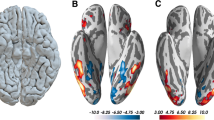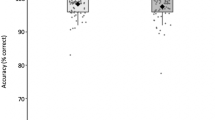Abstract
Prosopagnosia is a disorder leading to difficulties in recognizing faces. However, recent evidence suggests that individuals with congenital prosopagnosia can achieve considerable accuracy when they have to recognize their own faces (self-face advantage). Yet, whether this advantage is face-specific or not is still unclear. Here, we aimed to investigate whether individuals with congenial prosopagnosia show a self-advantage also in recognizing other self body-parts and, if so, whether the advantage for the body parts differs from the one characterizing the self-face. Eight individuals with congenital prosopagnosia and 22 controls underwent a delayed matching task in which they were required to recognize faces, hands and feet belonging to the self or to others. Controls showed a similar self-advantage for all the stimuli tested; by contrast, individuals with congenital prosopagnosia showed a larger self-advantage with faces compared to hands and feet, mainly driven by their deficit with others’ faces. In both groups the self-advantages for the different body parts were strongly and significantly correlated. Our data suggest that the self-face advantage showed by individuals with congenital prosopagnosia is not face-specific and that the same mechanism could be responsible for both the self-face and self body-part advantages.




Similar content being viewed by others
Notes
Since previous papers have suggested that females tend to outperform males in different test of face recognition (Herlitz and Lovén 2013; Herlitz and Yonker 2002; Rennels and Cummings 2013) we first verified whether there was any difference in performance between female and male participants in both the control and CP groups. For each one of our conditions, independent samples t-test between female and male participants were run on the accuracy, RTs and IES data of the control participants, while the performance of the male individual with CP was compared to the one of the female individuals with CP by using single-subject statistics (Crawford and Garthwaite 2002). No significant differences were found between female and male controls in any of the conditions (all ps > 0.05). Similarly, in the CP group, the performance of the male individual was comparable to the one of the females in all conditions (all ps > 0.05). Given these results, we decided to exclude the participant’s genders from the factor list in all subsequent analyses.
References
Albonico A, Malaspina M, Daini R (2017) Italian normative data and validation of two neuropsychological tests of face recognition: Benton Facial Recognition Test and Cambridge Face Memory Test. Neurol Sci 38(9):1637–1643
Bank S, Rhodes G, Read A, Jeffery L (2015) Face and body recognition show similar improvement during childhood. J Exp Child Psychol 137:1–11
Barton JJ, Corrow SL (2016) The problem of being bad at faces. Neuropsychologia 89:119–124. https://doi.org/10.1016/j.neuropsychologia.2016.06.008
Behrmann M, Avidan G (2005) Congenital prosopagnosia: face-blind from birth. Trends Cogn Sci 9(4):180–187. https://doi.org/10.1016/j.tics.2005.02.011
Behrmann M, Avidan G, Marotta JJ, Kimchi R (2005) Detailed exploration of face-related processing in congenital prosopagnosia: 1. Behavioral findings. J Cogn Neurosci 17(7):1130–1149. https://doi.org/10.1162/0898929054475154
Bentin S, Deouell LY, Soroker N (1999) Selective visual streaming in face recognition: evidence from developmental prosopagnosia. Neuroreport 10(4):823–827
Biotti F, Gray KL, Cook R (2017) Impaired body perception in developmental prosopagnosia. Cortex 93:41–49
Bodamer J (1947) Die prosop-agnosie. Arch Psychiatr Nervenkr Z Gesamte Neurol Psychiatr 179:6–53
Bowles DC, McKone E, Dawel A, Duchaine B, Palermo R, Schmalzl L,.. . Yovel G (2009) Diagnosing prosopagnosia: effects of ageing, sex, and participant-stimulus ethnic match on the Cambridge Face Memory Test and Cambridge Face Perception Test. Cogn Neuropsychol 26(5):423–455. https://doi.org/10.1080/02643290903343149
Brady N, Campbell M, Flaherty M (2004) My left brain and me: a dissociation in the perception of self and others. Neuropsychologia 42(9):1156–1161. https://doi.org/10.1016/j.neuropsychologia.2004.02.007
Brady N, Campbell M, Flaherty M (2005) Perceptual asymmetries are preserved in memory for highly familiar faces of self and friend. Brain Cogn 58(3):334–342. https://doi.org/10.1016/j.bandc.2005.01.001
Bruyer R, Brysbaert M (2011) Combining speed and accuracy in cognitive psychology: is the inverse efficiency score (IES) a better dependent variable than the mean reaction time (RT) and the percentage of errors (PE)? Psychologica Belgica 51(1):5–13
Burton AM, Wilson S, Cowan M, Bruce V (1999) Face recognition in poor-quality video: Evidence from security surveillance. Psychol Sci 10(3):243–248
Cattaneo Z, Daini R, Malaspina M, Manai F, Lillo M, Fermi V, Comincini S (2016) Congenital prosopagnosia is associated with a genetic variation in the oxytocin receptor (OXTR) gene: an exploratory study. Neuroscience 339:162–173. https://doi.org/10.1016/j.neuroscience.2016.09.040
Cook R, Johnston A, Heyes C (2012) Self-recognition of avatar motion: how do I know it’s me?. Proc R Soc B 279(1729):669–674
Crawford JR, Garthwaite PH (2002) Investigation of the single case in neuropsychology: Confidence limits on the abnormality of test scores and test score differences. Neuropsychologia 40(8):1196–1208
Dalrymple KA, Palermo R (2016) Guidelines for studying developmental prosopagnosia in adults and children. Cogn Sci 7(1):73–87
Damasio AR, Damasio H, Van Hoesen GW (1982) Prosopagnosia: anatomic basis and behavioral mechanisms. Neurology 32(4):331–341
De Haan EH (1999) A familial factor in the development of face recognition deficits. J Clin Exp Neuropsychol 21(3):312–315. https://doi.org/10.1076/jcen.21.3.312.917
De Haan EH, Campbell R (1991) A fifteen year follow-up of a case of developmental prosopagnosia. Cortex 27(4):489–509
De Renzi E, di Pellegrino G (1998) Prosopagnosia and alexia without object agnosia. Cortex 34(3):403–415
de Gelder B, Rouw R (2000) Configural face processes in acquired and developmental prosopagnosia: evidence for two separate face systems? Neuroreport 11(14):6
Devue C, Collette F, Balteau E, Degueldre C, Luxen A, Maquet P, Bredart S (2007) Here I am: the cortical correlates of visual self-recognition. Brain Res 1143:169–182. https://doi.org/10.1016/j.brainres.2007.01.055
Downing PE, Jiang Y, Shuman M, Kanwisher N (2001) A cortical area selective for visual processing of the human body. Science 293(5539):2470–2473
Duchaine B, Garrido L (2008) We're getting warmer—characterizing the mechanisms of face recognition with acquired prosopagnosia: A comment on Riddoch et al. (2008). Cogn Neuropsychol 25(5):765–768. https://doi.org/10.1080/02643290802092102
Duchaine B, Nakayama K (2006) The Cambridge face memory test: results for neurologically intact individuals and an investigation of its validity using inverted face stimuli and prosopagnosic participants. Neuropsychologia 44(4):576–585. https://doi.org/10.1016/j.neuropsychologia.2005.07.001
Duchaine B, Parker H, Nakayama K (2003) Normal recognition of emotion in a prosopagnosic. Perception 32(7):827–838
Duchaine B, Yovel G, Butterworth EJ, Nakayama K (2006) Prosopagnosia as an impairment to face-specific mechanisms: Elimination of the alternative hypotheses in a developmental case. Cogn Neuropsychol 23(5):714–747. https://doi.org/10.1080/02643290500441296
Duchaine B, Germine L, Nakayama K (2007) Family resemblance: ten family members with prosopagnosia and within-class object agnosia. Cogn Neuropsychol 24(4):419–430. https://doi.org/10.1080/02643290701380491
Farah MJ, Levinson KL, Klein KL (1995a) Face perception and within-category discrimination in prosopagnosia. Neuropsychologia 33(6):661–674
Farah MJ, Wilson KD, Drain HM, Tanaka JR (1995b) The inverted face inversion effect in prosopagnosia: evidence for mandatory, face-specific perceptual mechanisms. Vision Res 35(14):2089–2093
Frassinetti F, Maini M, Romualdi S, Galante E, Avanzi S (2008) Is it mine? Hemispheric asymmetries in corporeal self-recognition. J Cogn Neurosci 20(8):1507–1516. https://doi.org/10.1162/jocn.2008.20067
Frassinetti F, Pavani F, Zamagni E, Fusaroli G, Vescovi M, Benassi M, Farne A (2009) Visual processing of moving and static self body-parts. Neuropsychologia 47(8–9):1988–1993. https://doi.org/10.1016/j.neuropsychologia.2009.03.012
Frassinetti F, Maini M, Benassi M, Avanzi S, Cantagallo A, Farne A (2010) Selective impairment of self body-parts processing in right brain-damaged patients. Cortex 46(3):322–328. https://doi.org/10.1016/j.cortex.2009.03.015
Frassinetti F, Ferri F, Maini M, Benassi MG, Gallese V (2011) Bodily self: an implicit knowledge of what is explicitly unknown. Exp Brain Res 212(1):153–160. https://doi.org/10.1007/s00221-011-2708-x
Garrido L, Duchaine B, Nakayama K (2008) Face detection in normal and prosopagnosic individuals. J Neuropsychol 2(1):119–140. https://doi.org/10.1348/174866407x246843
Grueter M, Grueter T, Bell V, Horst J, Laskowski W, Sperling K, Kennerknecht I (2007) Hereditary prosopagnosia: the first case series. Cortex 43(6):734–749
Herlitz A, Lovén J (2013) Sex differences and the own-gender bias in face recognition: a meta-analytic review. Visual Cognition 21(9–10):1306–1336
Herlitz A, Yonker JE (2002) Sex differences in episodic memory: the influence of intelligence. J Clin Exp Neuropsychol 24(1):107–114. https://doi.org/10.1076/jcen.24.1.107.970
Humphreys K, Avidan G, Behrmann M (2007) A detailed investigation of facial expression processing in congenital prosopagnosia as compared to acquired prosopagnosia. Exp Brain Res 176(2):356–373. https://doi.org/10.1007/s00221-006-0621-5
Jiahui G, Yang H, Duchaine B (2018) Developmental prosopagnosics have widespread selectivity reductions across category-selective visual cortex. Proc Nat Acad Sci 2018:2246
Jones RD, Tranel D (2001) Severe developmental prosopagnosia in a child with superior intellect. J Clin Exp Neuropsychol 23(3):265–273. https://doi.org/10.1076/jcen.23.3.265.1183
Kanwisher N, McDermott J, Chun MM (1997) The fusiform face area: a module in human extrastriate cortex specialized for face perception. J Neurosci 17(11):4302–4311
Kaplan JT, Goodglass H, Weintraub S (1983) The Boston naming test. 2nd. Lea & Febiger, Philadelphia
Keyes H, Brady N (2010) Self-face recognition is characterized by “bilateral gain” and by faster, more accurate performance which persists when faces are inverted. Q J Exp Psychol (Hove) 63(5):840–847. https://doi.org/10.1080/17470211003611264
Kircher TT, Senior C, Phillips ML, Benson PJ, Bullmore ET, Brammer M, David AS (2000) Towards a functional neuroanatomy of self processing: effects of faces and words. Brain Res Cogn Brain Res 10(1–2):133–144
Klein SB, Gabriel RH, Gangi CE, Robertson TE (2008) Reflections on the self: a case study of a prosopagnosic patient. Soc Cogn 26(6):12
Kress T (2003) Event-related potentials reflect impaired face recognition in patients with congenital prosopagnosia. Neurosci Lett. https://doi.org/10.1016/s0304-3940(03)01040-1
Kress T, Daum I (2003) Developmental prosopagnosia: a review. Behav Neurol 14(3–4):109–121
Lange J, de Lussanet M, Kuhlmann S, Zimmermann A, Lappe M, Zwitserlood P, Dobel C (2009) Impairments of biological motion perception in congenital prosopagnosia. PloS One 4(10):e7414. https://doi.org/10.1371/journal.pone.0007414
Longmore CA, Liu CH, Young AW (2008) Learning faces from photographs. J Exp Psychol Hum Percept Perform 34(1):77
Ma Y, Han S (2010) Why we respond faster to the self than to others? An implicit positive association theory of self-advantage during implicit face recognition. J Exp Psychol Hum Percept Perform 36(3):619–633. https://doi.org/10.1037/a0015797
Malaspina M, Albonico A, Daini R (2016) Right perceptual bias and self-face recognition in individuals with congenital prosopagnosia. Laterality 21(2):118–142. https://doi.org/10.1080/1357650X.2015.1084312
Malaspina M, Albonico A, Toneatto C, Daini R (2017) What do eye movements tell us about the visual perception of individuals with congenital prosopagnosia? Neuropsychology 31(5):546
Malaspina M, Albonico A, Lao J, Caldara R, Daini R (2018) Mapping self-face recognition strategies in congenital prosopagnosia. Neuropsychology 32(2):123–137
Mathôt S, Schreij D, Theeuwes J (2012) OpenSesame: an open-source, graphical experiment builder for the social sciences. Behav Res Methods 44(2):314–324
McConachie HR (1976) Developmental prosopagnosia. A single case report. Cortex 12(1):76–82
McKone E, Hall A, Pidcock M, Palermo R, Wilkinson RB, Rivolta D, O’Connor KB (2011) Face ethnicity and measurement reliability affect face recognition performance in developmental prosopagnosia: evidence from the Cambridge Face Memory Test-Australian. Cogn Neuropsychol 28(2):109–146. https://doi.org/10.1080/02643294.2011.616880
Minnebusch DA, Suchan B, Daum I (2009) Losing your head: behavioral and electrophysiological effects of body inversion. J Cogn Neurosci 21(5):865–874. https://doi.org/10.1162/jocn.2009.21074
Moro V, Pernigo S, Avesani R, Bulgarelli C, Urgesi C, Candidi M, Aglioti SM (2012) Visual body recognition in a prosopagnosic patient. Neuropsychologia 50(1):104–117. https://doi.org/10.1016/j.neuropsychologia.2011.11.004
Parketny J, Towler J, Eimer M (2015) The activation of visual face memory and explicit face recognition are delayed in developmental prosopagnosia. Neuropsychologia 75:538–547
Platek SM, Keenan JP, Gallup GG, Mohamed FB (2004) Where am I? The neurological correlates of self and other. Brain Res Cogn Brain Res 19(2):114–122. https://doi.org/10.1016/j.cogbrainres.2003.11.014
Platek SM, Loughead JW, Gur RC, Busch S, Ruparel K, Phend N, Langleben DD (2006) Neural substrates for functionally discriminating self-face from personally familiar faces. Hum Brain Mapp 27(2):91–98. https://doi.org/10.1002/hbm.20168
Reed CL, Stone VE, Bozova S, Tanaka J (2003) The body-inversion effect. Psychol Sci 14(4):302–308
Rennels JL, Cummings AJ (2013) Sex differences in facial scanning: similarities and dissimilarities between infants and adults. Int J Behav Dev 37(2):111–117
Rice A, Phillips PJ, O'Toole A (2013) The role of the face and body in unfamiliar person identification. Appl Cogn Psychol 27(6):761–768
Righart R, de Gelder B (2007) Impaired face and body perception in developmental prosopagnosia. Proc Natl Acad Sci USA 104(43):17234–17238. https://doi.org/10.1073/pnas.0707753104
Rivolta D, Lawson RP, Palermo R (2017) More than just a problem with faces: altered body perception in a group of congenital prosopagnosics. Q J Exp Psychol (Hove) 70(2):276–286. https://doi.org/10.1080/17470218.2016.1174277
Robbins RA, Coltheart M (2012) The effects of inversion and familiarity on face versus body cues to person recognition. J Exp Psychol Hum Percept Perform 38(5):1098–1104. https://doi.org/10.1037/a0028584
Schmalzl L, Palermo R, Green M, Brunsdon R, Coltheart M (2008) Training of familiar face recognition and visual scan paths for faces in a child with congenital prosopagnosia. Cogn Neuropsychol 25(5):704–729. https://doi.org/10.1080/02643290802299350
Sergent J, Signoret JL (1992) Functional and anatomical decomposition of face processing: evidence from prosopagnosia and PET study of normal subjects. Philos Trans R Soc Lond B Biol Sci 335(1273):55–61. https://doi.org/10.1098/rstb.1992.0007 (discussion 61–52).
Shah P, Gaule A, Gaigg SB, Bird G, Cook R (2015a) Probing short-term face memory in developmental prosopagnosia. Cortex 64:115–122
Shah P, Gaule A, Sowden S, Bird G, Cook R (2015b) The 20-item prosopagnosia index (PI20): a self-report instrument for identifying developmental prosopagnosia. R Soc Open Sci 2(6):140343. https://doi.org/10.1098/rsos.140343
Sugiura M, Watanabe J, Maeda Y, Matsue Y, Fukuda H, Kawashima R (2005) Cortical mechanisms of visual self-recognition. Neuroimage 24(1):143–149. https://doi.org/10.1016/j.neuroimage.2004.07.063
Susilo T, Yovel G, Barton JJ, Duchaine B (2013) Face perception is category-specific: evidence from normal body perception in acquired prosopagnosia. Cognition 129(1):88–94. https://doi.org/10.1016/j.cognition.2013.06.004
Uddin LQ, Kaplan JT, Molnar-Szakacs I, Zaidel E, Iacoboni M (2005) Self-face recognition activates a frontoparietal “mirror” network in the right hemisphere: an event-related fMRI study. Neuroimage 25(3):926–935. https://doi.org/10.1016/j.neuroimage.2004.12.018
Van den Stock J, van de Riet WA, Righart R, de Gelder B (2008) Neural correlates of perceiving emotional faces and bodies in developmental prosopagnosia: an event-related fMRI-study. PloS one 3(9):e3195. https://doi.org/10.1371/journal.pone.0003195
Willenbockel V, Sadr J, Fiset D, Horne GO, Gosselin F, Tanaka JW (2010) Controlling low-level image properties: the SHINE toolbox. Behav Res Methods 42(3):671–684. https://doi.org/10.3758/brm.42.3.671
Yin RK (1969) Looking at upside-down faces. J Exp Psychol 81(1):56
Acknowledgements
We would like to thank Cecilia Cannistraci for her precious help in data recruitment and all the participants who took part in the study. We would also like to thank the anonymous reviewers for their insightful and valuable comments on the manuscript. The authors have no conflict of interest to declare.
Author information
Authors and Affiliations
Corresponding author
Rights and permissions
About this article
Cite this article
Malaspina, M., Albonico, A. & Daini, R. Self-face and self-body advantages in congenital prosopagnosia: evidence for a common mechanism. Exp Brain Res 237, 673–686 (2019). https://doi.org/10.1007/s00221-018-5452-7
Received:
Accepted:
Published:
Issue Date:
DOI: https://doi.org/10.1007/s00221-018-5452-7




